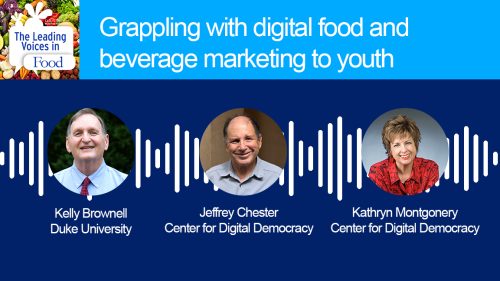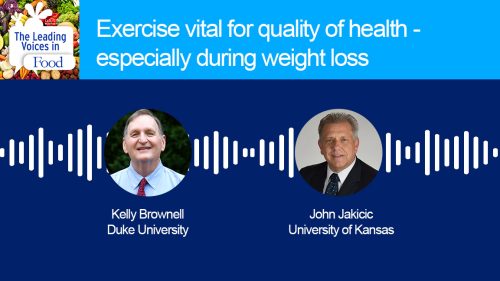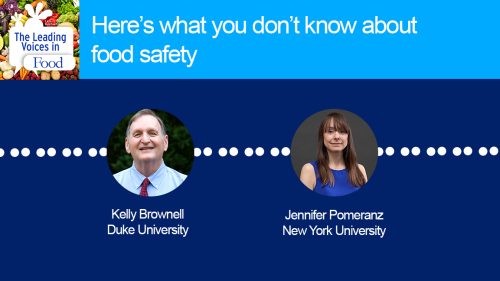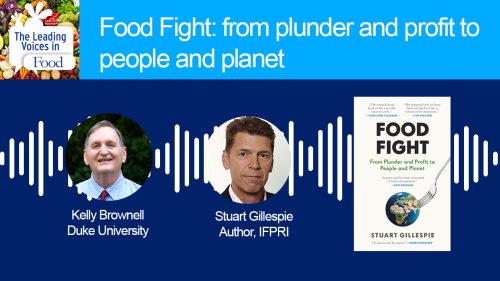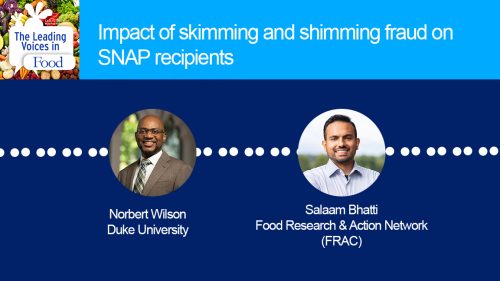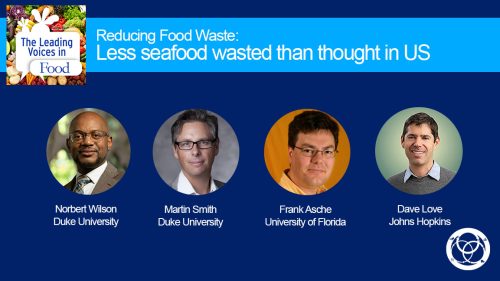The Leading Voices in Food
E223: Food Policy Lessons from Removing Trans Fats from our Diet
In August of 2023, the Food and Drug Administration issued something known as a direct final rule, disregarded trans fats in the food supply. Consumers won’t notice changes as the rule just finalizes FDA’s 2015 ruling that partially hydrogenated oils – trans fats – no longer had “GRAS status.” GRAS stands for generally regarded as safe. We cover this issue today because this trans fat ban was the product of lots of work by a key group of scientists, the advocacy community, and others. The anatomy of this process can teach us a lot about harnessing scientific discovery for social and policy change. At the center of all this is today’s guest, Dr. Walter Willett. Walter Willett is one of the world’s leading nutrition researchers. He is professor of epidemiology and nutrition at the Harvard T.H. Chan School of Public Health, and for many years served as chair of its Department of Nutrition. He’s published extensively, been elected to the National Academy of Medicine, and it turns out, is the world’s most cited nutrition researcher.
Subscribe: Apple Podcasts | TuneIN | YouTube Music | SoundCloud | PocketCasts | Radio Public
Tags: Advocacy & Food | Diet & Nutrition | Food Industry Behavior & Marketing | Food Policy | Food Safety & Food Defense |

Walter C. Willett, M.D., Dr. P.H., is Professor of Epidemiology and Nutrition at Harvard T.H. Chan School of Public Health. Dr. Willett studied food science at Michigan State University, and graduated from the University of Michigan Medical School before obtaining a Masters and Doctorate in Public Health from Harvard T.H. Chan School of Public Health. Dr. Willett has focused much of his work over the last 40 years on the development and evaluation of methods, using both questionnaire and biochemical approaches, to study the effects of diet on the occurrence of major diseases. He has applied these methods starting in 1980 in the Nurses’ Health Studies I and II and the Health Professionals Follow-up Study. Together, these cohorts that include nearly 300,000 men and women with repeated dietary assessments, are providing the most detailed information on the long-term health consequences of food choices. Dr. Willett has published over 2,000 original research papers and reviews, primarily on lifestyle risk factors for heart disease, cancer, and other conditions and has written the textbook, Nutritional Epidemiology, published by Oxford University Press, now in its third edition. He also has written four books for the general public. Dr. Willett is the most cited nutritionist internationally. He is a member of the National Academy of Medicine of the National Academy of Sciences and the recipient of many national and international awards for his research.
Interview Summary
There are so many things I could talk to you about because you do work in such an array of really important areas and have just made contribution after contribution for years. But let’s talk about the trans fat because you were there at the very beginning, and it ended up with a profound public policy ruling that has major implications for the health of the country. I’d like to talk about how this all occurred. So, tell us, if you would, what are trans fats, how present were they in the food supply over the years, and what early discoveries did you and others make that led you to be concerned?
Yes, this is a story from which I’ve learned a lot, and hopefully others might as well. Trans fats are produced by the process called partial hydrogenation. This takes liquid vegetable oils, like soybean oils, corn oil, canola oil, and subjects them to a process with high heat and bubbling hydrogen through the oil. What this is doing is taking essential molecules, essential fatty acids like the omega-6 and omega-3 fatty acids and twisting their shapes just subtly, and this turns them into a solid fat instead of a liquid fat. And, of course, the food industry likes this because our culture, the Northern European eating culture, emphasizes solid fats like butter and lard. Industry really didn’t know what to do with all the liquid oil that they were able to produce by another process that was discovered back in the late 1800s. The partial hydrogenation process was actually developed in about 1908, and someone actually got a Nobel Prize for that. It wasn’t used widely in the food industry till the 1930s and 1940s when it was upscaled because it was cheaper, for multiple reasons, to partially hydrogenate oils and turn them into solid fats like Cricso and margarines. I got worried about this, actually, back in the 1970s, when other scientists were discovering that these essential fatty acids are important for many biological processes, clotting, arrhythmias, inflammation, and counteracting inflammation. I realized while studying food science at that time that there was nobody really keeping an eye on this. That there were these synthetic fatty acids in massive amounts in our food supplies. Margarines, vegetable shortenings were up to 30% and 40% made of trans fatty acids. And that may me concerned that this could have a big downside. So, back in 1980, with the help of some people at the Department of Agriculture developing a database for trans fats in foods, we began collecting data on trans fat intake in our large cohort studies. And about 20 years later, we saw that trans fat intake was related to risk of heart disease. We published that in 1993. That got us started on the pathway to getting them out of our food supply.
Let’s talk about how present they were in the food supply. You mentioned some things like margarine and Crisco, but these fats were in a lot of different products, weren’t they?
Yes, they were almost everywhere. You could hardly pick up a product that had a nutrition facts label that didn’t say partially hydrogenated fat on it. It was really in virtually everything that was industrially made in our food system.
Just because they could produce them at low cost? Or did they have other properties that were desirable from the industry’s point of view?
These trans fats had multiple characteristics. One, they could be solid. And again, because they mimicked butter and lard, it fit into lots of foods. Second, they had very long shelf life. Third, you could heat them up and use them for deep frying, and they could sit there in fryolators for days and not be changed. So, this was all good for the food system. It wanted really long shelf life and started with cheap ingredients.
So, after those initial findings that raised red flags, what kind of research did you do subsequently and at what level of proof did you feel policy change might be warranted?
Within our own group, we continued to follow our participants. These are close to 100,000 women in the Nurses’ Health Study, and also another 50,000 in the health professionals follow up study. We confirmed our initial findings and then found that trans fats were related to risk of many other conditions, from diabetes to infertility. And simultaneous with our work in the 1990s, some of our colleagues in the Netherlands were doing what we called controlled feeding studies. These studies take a few dozen people and feed them high trans fat or low trans fat for a few weeks and watch what happens to risk factors like cholesterol levels and triglyceride levels. And they found that trans fats had uniquely adverse consequences. They raised the bad cholesterol, LDL cholesterol, and reduced the good cholesterol, HDL cholesterol. So, they had unique adverse biological effects. It was really that combination of that short-term kind of study and the long-term epidemiologic studies we were doing that made a compelling case that trans fats were the cause of cardiovascular disease.
So, a line of considerable work took place over a number of years, and then got to that point where you felt something needed to be done. And the fact that you did that science and that you were worried about these trans fats in the first place is impressive because you were really onto something important. But what happened after you did the series of studies? What steps occurred and who were the key actors that finally led to policy change occurring?
Well, as we expected, there was pushback from the industry about this because they were so invested in trans fat. And I was actually disappointed that a lot of our colleagues in the American Heart Association and others pushed back as well. They didn’t want to distract from saturated fat. But, when studies were reproduced, it was really undeniable that there was a problem. But, if the studies had just been put on a shelf and sitting there, probably nothing would’ve happened. And it was really important that we partnered with advocacy groups, particularly Mike Jacobson, Margo Wootan at the Center for Science in the Public Interest, because they had a readership and audience that we didn’t have. And they also were more familiar with the workings of the Food and Drug Administration and government in general. But I also was told somewhere around that time that women, who are the main food purchases, pay most attention to a lot of the women’s journals, Family Circle, those kinds of journals. And actually, for good reasons. Their journalists are very good. So, I’ve talked to those journalists every opportunity. And it turned out it was really important to have some public awareness about this problem. If it was just good science and things worked as they should have, the FDA would’ve looked at the evidence and just ruled out trans fat from our food supply early on, but they didn’t. It really took major concerted effort by the combination of the scientific community and the advocacy group.
Did you bump into conflict of interest problems with other scientists who were receiving funding from the industry and you know them talking to the press or speaking at conferences or things like that?
Well, there’s plenty of conflicts of interest within the nutrition community, but actually, I don’t think that was so much of an problem here. In some ways, there was a conflict of sort of personal commitment to entirely focusing on saturated fat and not wanting to see any distraction. I don’t think a conflict of interest in the economic monetary sense.
Walter, I remember back when this discussion was occurring and industry was fighting back. They made claims that food prices would go up, that the quality of foods would go down, that it would be a real hit to their business because consumers wouldn’t like products without the trans fats. What became of all those arguments?
It’s interesting and it’s important to keep in mind that the industry is not monolithic. And I have to credit Unilever, actually, with paying attention to the scientific evidence, which was really rejected here. Interestingly, at that time, all the major margarine manufacturers were owned by the tobacco industry. And you can imagine that those CEOs were not getting out of their bed in the morning and saying, well, what can I do to make Americans healthier? No, they were not interested in health. But Unilever was a food company and it was invested in staying as a food company for the continuing future. And they did realize that this was a problem, and they invested a lot of money to re-engineer their products, re-engineer their production of margarine and shortening. And they did take trans fat out of their products. They obviously did a lot of taste testing to make sure they were acceptable. And once they did that, the industry could no longer say that it’s impossible to do it. It’s sort of like the automobile industry when Detroit said, you just can’t build low pollution cars, but then the Japanese did it and then they could no longer deny it.
Boy, it’s such an interesting story that occurred. With Unilever getting involved as they did. That must have been a very positive push forward. They’re second biggest food company in the world.
That was really helpful. And again, I think it was because they had a lot of scientists, both nutritionists and food chemists. I was told they had about 800 such employees at that time. They could see, if you looked at the evidence honestly, this was a serious issue. One of their chief scientists later told me that it was actually one of our editorials in the American Journal of Public Health where we estimated that there would be about 80,000 premature deaths per year due to trans fat. And once they saw that, they said, we can’t have Willett going around saying there’s going to be 80,000 premature deaths, and they realized they had to do something. It’s interesting, you write an editorial, you don’t know who’s going to read it, but sometimes it hits one person who can really make a difference.
It is nice to know that people read things like that once in a while. Let’s go to where you were at that point. You produced a lot of science. You were communicating this to professional audiences, but also to the general public with interviews and magazines and things like that. And the advocacy community, especially the Center for Science in the Public Interest, got activated. What happened then?
Well, a couple things happened. One is that they brought up and proposed labeling trans fat on the nutrition facts label and submitted that to the FDA. The FDA sat on it. There was, of course, lots of backdoor action by the American food industry that did not want to change what they were doing. And despite some prodding by CSPI over the years, that sat there for about 10 years almost. Ironically, there was a faculty member at Harvard Chan School of Public Health at that time who had seen a display we had done on trans fat. We built a big tower out of blocks of trans fat and had a little poster there talking about it. He went to Washington and became a senior person at the Office for Management and Budget. And Mike Jacobson went to go visit him with a petition to label trans fat, and our faculty person said, I know about trans fat because Willnett had that display in our cafeteria. He wrote a letter to the FDA that was quite unprecedented, basically saying that either put trans fat on the food label or tell us why not. Which is a quite strong letter. And then the wheels started turning, and there was delay and delay for a pushback on the food industry. But by 2008, trans fat actually did get on the food label. And that had a very major impact, because once it had to be on the label, the food industry took it out. They sort of knew it was coming because they didn’t want to admit it publicly. But I think they understood for quite a while that they were going to have to get it out, but that was really the turning point. All of a sudden, almost all the food products had zero on the trans fat line there.
Let’s talk about the public health impact of this. You mentioned 80,000 or some deaths occurring each year attributable to consumption of trans fat. Can we conclude from that that we’re saving that many lives now with trans fat out of the food supply? And does that mean 80,000 lives year after year after year?
It’s hard to know exactly and of course, so many things are going on at the same time. And the trans fat didn’t go down abruptly because Unilever was, even in the American market, a pretty major producer, starting by the mid 1990s, trans fat intake actually did start to go down. And other things are going on, obviously obesity epidemic counterbalancing a lot of positive things that were happening. But, there were some economists looking at communities that adopted trans fat bans early on versus those that did not, and they could show there was a divergence in heart attacks and hospitalizations for heart disease. So it’s hard to pin an exact number on it, again, because all these things happen at the same time. But it’s quite clear that we would be having quite a bit more heart disease if trans fat had not been eliminated. I would also look back to another important step in the process because even though we got trans fat on the food label, and the products that had it quite quickly became, almost all of them, zero trans fat, but that didn’t deal with a restaurant industry, which was also a very big source of trans fat. And there it took community activists to make this happen. There was a small community in Northern California that was really the first community that banned trans fat in restaurants, and a few other places did. But then Mayor Bloomberg of New York, there’s another backstory why he got interested in this. But it’s one of these things, you put out information and you don’t know who’s going to read it, and someone had read some of our work and to convince his health department and Bloomberg himself that trans fats had to go, and New York banned trans fats. And then some other communities, Massachusetts and elsewhere in the food industry, the restaurant industry realized they couldn’t have a patchwork distribution system. And so that was a tipping point that trans fat was eliminated in the food service industry long before the FDA finally made the ruling. In fact, by the time the FDA made the ruling about trans fat and pressure hydrogenated fat, it was almost gone.
To go back and look at the history of this, it’s a relatively small number of key people taking the right actions at the right time that ultimately led to change. And thank goodness for those people like you and Mike Jacobson, Margo Wootan, and Mayor Bloomberg, and a few other people in political circles that took the bull by the horns and really got something done. Very impressive. As you look back on this, what lessons did you learn that you think might be helpful for future policy changes?
I think there are a number of lessons. I’d like to think, first of all, that solid good science is really important. Without that, we couldn’t have a hard time making changes that we need to do. But that’s usually not going to be enough. It’s really important to work with advocacy groups like CSPI. It’s important, sometimes, to work with journalists and provide good information, education. But it’s hard to know exactly which path is going to be successful. One thing is quite clear, in this country, in many areas, change does not happen from the top. It’s not enough just to have good science. And oftentimes, changes happen from the bottom up at the local level, the state level, and the national government may be the last place where action occurs.
So what changes in the food supply do you feel would be most pressing right now?
We certainly have a lot of problems in our food supply. If you look around, most people are consuming diets and beverages that are quite unhealthy. And there are so many issues, I think, still and we’ve worked on this issue is a sugar sweetened beverage issue, and we’ve had some real progress in that area, but still, there’s a huge way to go to reduce sugar sweetened beverages. But that’s part of a bigger problem in terms of what we’re consuming. And I would call that carbohydrate quality, that about half of our calories come from carbohydrates. In about 80% of that half, in other words, about 40%, of all the calories we consume are refined starch, sugar, and potatoes which have adverse metabolic effects, lead to weight gain, lead to diabetes, lead to cardiovascular disease. So that’s a huge area that we need to work on.
You’ve talked, so far, with the trans fat and, you know, and with other things in the food supply like salt, these are things that you’d be taking out of the food. That all makes good sense. What about putting things in? Talk about things that might support the microbiome, more fiber, or things that might support brain health and things like that, so what are your feeling about those things?
You’re right, our problems are both what’s there in quantities that are unhealthy and also what’s missing. Inadequate fiber intake is actually part of the carbohydrate problem. Clearly, we should be consuming many more whole grains compared to the amount of refined grains that we consume. And, of course, we get some fiber from fruits and vegetables. So I think, in addition to this huge amount of unhealthy carbohydrates and inadequate amount of whole grains, we do need to be consuming more fruits and vegetables. And then on the sort of protein source side, we’re clearly consuming too much red meat and replacing that with plant protein sources like nuts, legumes, and soy products would be really important for direct human health. But also, that’s an area where the environmental and climate change issues are extremely pressing and shifting from a more animal-centric diet to more plant-centric diet would have enormous benefits for climate change as well as direct effects for human health.


